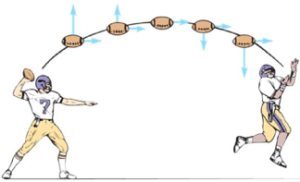Introduction to Physics
Physics in about understanding how the nature works and describe the principles of the nature by scientific languages. In this course, we will introduce the principles about four common phenomena of the nature, including the motion, optics, electricity, and magnetic field.
For examples, (i) how to describe a projectile trajectory of a thrown football and why the football moves with such a path? In fact, when you play other sports such as basketball, baseball, and soccer, all the motions follow the same principle, which is the Newton’s laws for motion; (ii) how to describe the image formed by a lens and why the image formed by a magnifier is larger than the real object? How the telescope works? The images formed by either mirror or lens follow the principles of reflection and refraction; (iii) Our modern society is built on electricity, then what is the nature of electric current and how the electric circuit works? (iv) To transport information, we use EM wave, in which the electric field and magnetic field are strongly coupled, then what is the nature of magnetic field? One interesting fact is that earth is a magnet with weak magnetic field. This magnetic field can efficiently shield the earth from harmful light from the Sun and which is also the reason why the compass works on earth.
Through this course, we will learn the answers for these interesting questions. The purpose is to help you understand the nature better and realize your daily life is full of Physics!




Student Learning Outcomes
Upon successful completion of the course, students will understand
- The relationship between the motion and the applied force
- The image formed through mirror (reflection) and lens (refraction) and the nature of the image
- The nature of the electric force between charged objects and the relationship between electric current and voltage in a circuit. The nature of the capacitor and resistor.
- The nature of the magnetic force between moving charged object and magnetic field. The relationship between electric current and magnetic field.
Course Requirements/Examinations
The criteria for assigning grades for the course are the following:
- Attendance of the lectures (10% of grade)
- Homework (50% of grade)
- Midterm exam (20% of grade)
- Final exam (20% of grade)
Credit Hours: 3
Course Instructors
Dr. Haidong Zhou, Course Director
 Haidong Zhou is an associate professor in the Department of Physics and Astronomy at UTK. Haidong obtained his PH.D. in Physics in December 2005 from University of Texas at Austin. He became a Postdoctoral Associate at National High Magnetic Field Lab/Florida Sate University with Prof. C. R. Wiebe. In August 2008, he obtained a position as assistant scholar/scientist in NHMFL. He became an Assistant Professor in the Physics Department at UTK in August 2012.
Haidong Zhou is an associate professor in the Department of Physics and Astronomy at UTK. Haidong obtained his PH.D. in Physics in December 2005 from University of Texas at Austin. He became a Postdoctoral Associate at National High Magnetic Field Lab/Florida Sate University with Prof. C. R. Wiebe. In August 2008, he obtained a position as assistant scholar/scientist in NHMFL. He became an Assistant Professor in the Physics Department at UTK in August 2012.
Haidong’s research is concerned with the nature of phase transitions in condensed matter systems, especially strongly correlated systems and quantum matters. More specifically, he is involved with the single crystal growth and using the x-ray scattering, low temperature and high magnetic field measurements, and neutron scattering, as complementary probes to study the spin, electron and structure of solids. His research interests are:
- Single crystal growth
- Geometrically frustrated magnets (GFM)
- Multiferroic systems
- Systems with strong spin/orbital/lattice coupling
- Systems approaching the itinerant electron limit